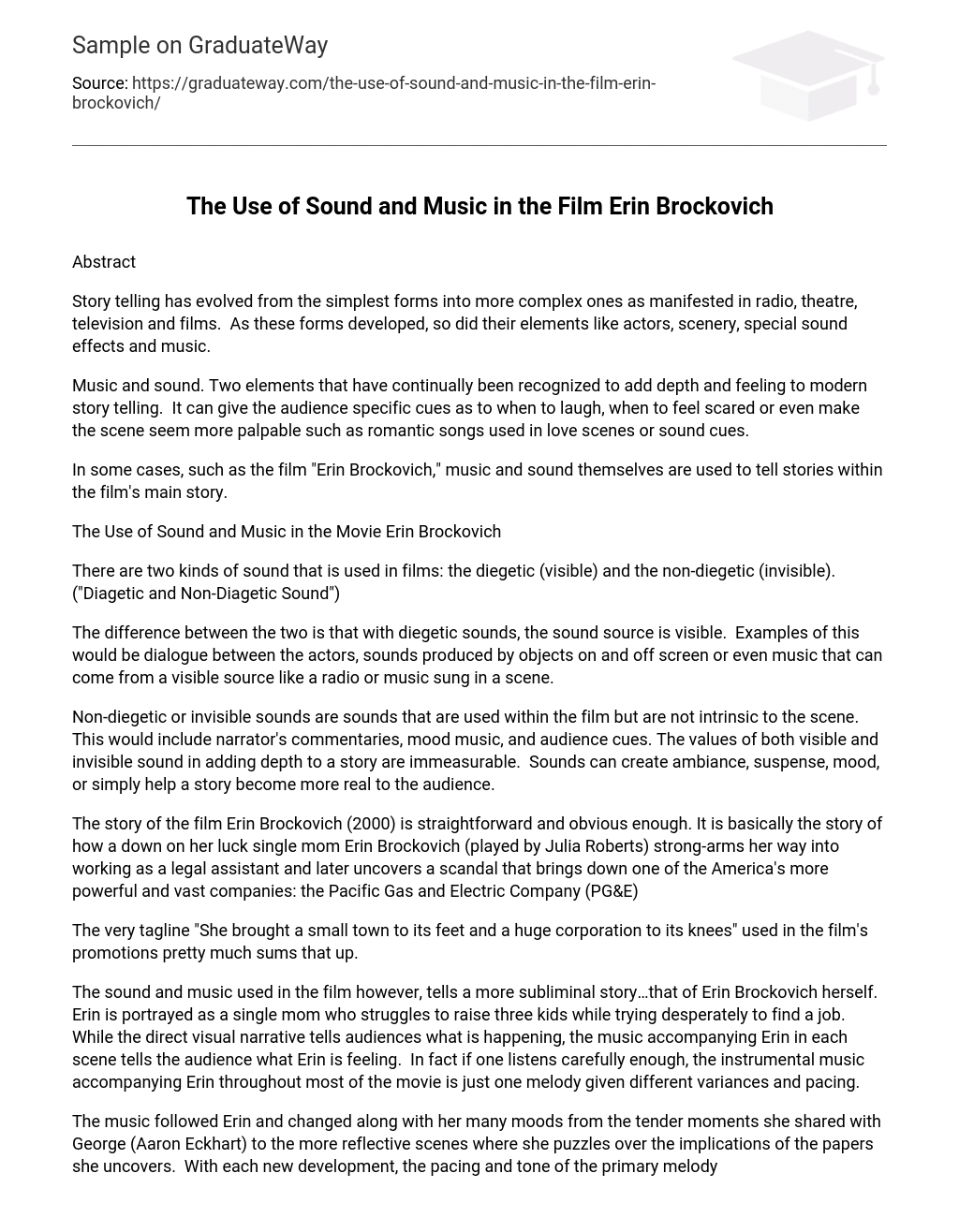Abstract
Story telling has evolved from the simplest forms into more complex ones as manifested in radio, theatre, television and films. As these forms developed, so did their elements like actors, scenery, special sound effects and music.
Music and sound. Two elements that have continually been recognized to add depth and feeling to modern story telling. It can give the audience specific cues as to when to laugh, when to feel scared or even make the scene seem more palpable such as romantic songs used in love scenes or sound cues.
In some cases, such as the film “Erin Brockovich,” music and sound themselves are used to tell stories within the film’s main story.
The Use of Sound and Music in the Movie Erin Brockovich
There are two kinds of sound that is used in films: the diegetic (visible) and the non-diegetic (invisible). (“Diagetic and Non-Diagetic Sound”)
The difference between the two is that with diegetic sounds, the sound source is visible. Examples of this would be dialogue between the actors, sounds produced by objects on and off screen or even music that can come from a visible source like a radio or music sung in a scene.
Non-diegetic or invisible sounds are sounds that are used within the film but are not intrinsic to the scene. This would include narrator’s commentaries, mood music, and audience cues. The values of both visible and invisible sound in adding depth to a story are immeasurable. Sounds can create ambiance, suspense, mood, or simply help a story become more real to the audience.
The story of the film Erin Brockovich (2000) is straightforward and obvious enough. It is basically the story of how a down on her luck single mom Erin Brockovich (played by Julia Roberts) strong-arms her way into working as a legal assistant and later uncovers a scandal that brings down one of the America’s more powerful and vast companies: the Pacific Gas and Electric Company (PG&E)
The very tagline “She brought a small town to its feet and a huge corporation to its knees” used in the film’s promotions pretty much sums that up.
The sound and music used in the film however, tells a more subliminal story…that of Erin Brockovich herself. Erin is portrayed as a single mom who struggles to raise three kids while trying desperately to find a job. While the direct visual narrative tells audiences what is happening, the music accompanying Erin in each scene tells the audience what Erin is feeling. In fact if one listens carefully enough, the instrumental music accompanying Erin throughout most of the movie is just one melody given different variances and pacing.
The music followed Erin and changed along with her many moods from the tender moments she shared with George (Aaron Eckhart) to the more reflective scenes where she puzzles over the implications of the papers she uncovers. With each new development, the pacing and tone of the primary melody changed. One might say that as Erin transformed herself, so did the music. It is also noticeable that the more “defining moments” Erin had, the more dynamic her personal soundtrack also sounded.
Diegetic sounds are also used to draw the audience’ attention to a new development in the story or as a lead in to a new scene. (Lastra, 2000, p. 99) For example in the scene where Erin was tucking in her kids for the night, she hears the roar of a Harley Davidson motorcycle that prompts her to go out and confront the source of the noise. This happens to be George who later turns out to be a significant character in her life.
Even the use of silence in the film made scenes more poignant. For instance, the scene where she is driving and listening to George’s story of her baby daughter Beth’s first word; There is neither music nor any other sound other than that of George’s voice telling Erin of each detail she missed. The silence shared with the audience the emptiness that Erin was feeling at having been away at one of her daughter’s milestones. Towards the end of the film, the sound track that accompanies Erin as she achieves more “actuality” and meaning in her work turns from an instrumental piece to the pop song “Everyday is a Winding Road” by Sheryl Crow.
Effective storytelling requires that the story be felt and become “real” to its audience. But not even the best written stories cover all the other “stories” that happen along with it.
References
Filmsound. Diegetic and Non-Diegetic Sound. Retrieved September 29, 2007 from
Filmsound.org.
http://www.filmsound.org/terminology/diegetic.htm#diegetic
Lastra, J. (2000). Sound Technology and the American Cinema: Perception, Representation, Modernity (J. Belton, Ed.). New York: Columbia University Press. Retrieved October 1, 2007, from Questia database: http://www.questia.com/PM.qst?a=o&d=100347895
Soderbergh, S. (Director) (2000) Erin Brockovich [Film]. USA: Jersey Films.





